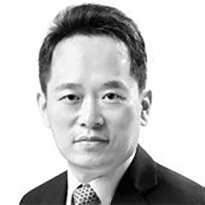[Column] Back to the mighty chip powerhouse

Kim Dong-ho
The author is the economic news editor for the JoongAng Ilbo.
Japan is changing fast. If you see the country as the “setting sun,” that’s a mistake. Some Koreans still use the disparaging phrase “Lost 40 years” to describe Japan’s lethargy. That is wrong. Japan is not the country it once was. The country is on a rebound after putting the long recession behind it.
The most noticeable change is Japan’s all-out attempt to regain its chip supremacy, as exemplified by the ongoing construction of semiconductor plants in Hokkaido and Kumamoto, the capital city of Kumamoto Prefecture on the island of Kyushu. The speed, method and goal of the projects are stunning. The chip production facility in Kumamoto — a plant of TSMC, or Taiwan Semiconductor Manufacture Co. — is being built 24/7.
Japan has dumped its pride. In the 1980s, the country took the lion’s share of the global chip market: its market capitalization accounted for nearly half the global market cap. Though hard to believe, it was true. Thanks to that pride, Japan transferred many chip technologies to Taiwan, a close ally of Japan.
Today, Japan aggressively imports chip production technology from Taiwan. Tokyo does not mind losing its face. Taipei also took a reciprocal action, apparently to hedge against security threats from China. Japan swiftly joined the U.S.-led Chip 4 alliance and the Indo-Pacific Economic Framework.
The ongoing U.S.-China confrontation has provoked Japan to restore its long-lost chip supremacy. The seismic shift in the semiconductor sector can serve as kamikaze — or “divine wind” — for Japan. A chip plant to be built by Rapidus — a chip consortium established by eight Japanese companies, including Sony, Toyota and NTT — is backed by IBM, once a juggernaut in the field. Given the unrivaled domination of the memory chip market by Samsung Electronics and SK hynix, it is not the target Japan wants to regain its supremacy over. But the explosive demand for non-memory chips from such fields as artificial intelligence and chatbots certainly offers Japan a new opportunity for the rebound. Rapidus is directly tackling the 2 nanometer micro processing.
In TSMC’s plant in Kumamoto, two chip production lines for 12 and 16 nanometers and 22 and 28 nanometers will be built. Once completed, the plant can produce 55,000 12-inch wafers every month on strong global demand. The plant will produce microcontroller units whose demand surged for image sensors and automobiles.
On its homepage, Rapidus declared to “develop and provide the world’s best cycle time shortening service from design, wafer process to 3D package.” That is a declaration to prove the real strength of Japan in systems on chips after losing to Samsung in memory chips. Japan still takes pride in monozukuri, a unique production style combining the development, technology and production of a certain product.
In a promising development, the Korean government announced an ambitious plan to create a massive chip cluster in Yongin, Gyeonggi. But it is too early to tell if the project will be successful. Samsung wasted years building an industrial road to its plant, while SK had trouble securing the industrial water needed to operate its factory after announcing a bold investment plan costing 120 trillion won ($91 billion). It is still questionable if Korea can outpace Japan, given the full-fledged support for chip production by both the central and local governments.
A bigger problem is Koreans’ attitude dismissive of the dramatic change in Japan. Shortly before Japan’s invasion of Korea in 1592 and Japan’s forced annexation of Korea in 1910, Korea did not squarely face reality. Even today, Japan claims territorial rights over Dokdo in the East Sea. Tokyo even denies the existence of wartime forced labor. Instead, it claims that Korean laborers voluntarily came to Japan to make money at Japanese companies during the Pacific War.
As Japan does not teach history correctly at schools, its postwar generations cannot but fall into collective oblivion. Tokyo still does not accept the brutal massacre of at least 6,600 Koreans living in Japan during the Great Kanto Earthquake of 1923. And yet, the country repeatedly appeals to the rest of the world for its victimhood from the atomic bombing in 1945. If that’s not a selective recognition of history, what is?
To live with the country in Northeast Asia, Korea must face a grim reality. If Korea does not want to repeat the sad chapter in its history, it must have technology leverage on chips — both memory and non-memory — while closely watching Japan’s movement with its eyes wide open. An emotional approach based on fueling anti-Japanese sentiment among Koreans does not help the country at all.










with the Korea JoongAng Daily
To write comments, please log in to one of the accounts.
Standards Board Policy (0/250자)